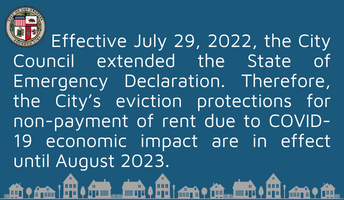The Performance Evaluation and Planning team works to refine and improve metrics, automate data gathering and analysis, and enhance data reporting and presentation. Our goal is to create meaningful performance data for internal use and for reporting to the public, the Mayor, City Council, other elected officials, our funders, and contractors. We also design graphic presentation of data and support HCIDLA’s strategic planning.
How well do HCIDLA's programs perform? Do they meet their goals? Where is room for improvement?
HCIDLA oversees the provision of a wide range of services and products to meet the needs of many different customers, which include some of the most vulnerable residents of Los Angeles. Measuring program performance outcomes shows the results of the services provided to improve the lives of City residents and stakeholders. Those services are paid for with tax dollars and fees, and sharing performance data with the public helps to create accountability for these program resources. HCIDLA services include:
- Routine inspection and enforcement of State and local habitability standards in multi-family rental housing (SCEP and complaint inspections)
- Rent Stabilization Ordinance (RSO) enforcement
- The Accessible Housing Program (AcHP) ensures that persons living with disabilities have an equal opportunity to rent, enjoy and use affordable rental housing funded by the City of Los Angeles or the Community Redevelopment Agency of the City of Los Angeles
- Supportive service programs offering counseling and case management, domestic violence and human trafficking shelters, emergency housing subsidies, after-school tutoring, and more
- Gap financing from the Affordable Housing Managed Pipeline and Proposition HHH for the development of new affordable rental housing or supportive housing for homeless persons including veterans, residents living with disabilities, including seniors and large families
- Investment in homeless shelters, services and homelessness prevention programs through the Los Angeles Homeless Services Authority (LAHSA)
- Homebuyer and home safety programs including first time homebuyer assistance, minor home repairs for elderly and disabled residents, remediation of lead-based paint hazards and healthy home education and interventions
- Planning, research, program evaluation and grants management
Strategic Plan 2018-2021
The strategic plan provides a platform to communicate the Department’s long-term vision, and align all efforts to achieve the HCIDLA’s goals and objectives with its vision and the departmental mission. Ten strategic goals, related metrics and annual targets are also described in the Plan.
Back to Basics Scorecard
The Back to Basics Scorecard provides a variety of metrics of HCIDLA services or operational outcomes corresponding to the Mayor’s citywide goals of a Los Angeles that is Safe, Livable, Prosperous and Well-Run. Click here to view the Back to Basics Scorecard.
Clarity Human Services System
Clarity Human Services (developed by Bitfocus, Inc.) is the case management and reporting software used to capture customer data, and to generate reports that meet the requirements of the Community Development Block Grant (CDBG) and the Community Services Block Grant (CSBG). These federal funds support the community-based programs. The data managed by Clarity Human Services is used for the Back to Basics Scorecard, the Annual Performance Evaluation/SOFA, internal program monitoring and evaluation tools, and other reports.
SOFA Performance Evaluation
The SOFA Performance Evaluation is conducted annually of grant-funded service provider contractors in the FamilySource System (FSS), and Domestic Violence Shelter Operations Program (DVSO). The Evaluation Categories are represented by the acronym SOFA where:
S – Measures the Customer Satisfaction of clients served.
O – Measures the number of Outcomes, or results experienced by clients after participation in program services and activities.
F -The Flow measure is the number of clients served during the year.
A -The Administrative Capability performance measure includes:
- Timely reporting and accuracy of participant activity;
- Compliance with program policies and procedures; and
- Accurate budgeting and financial management









